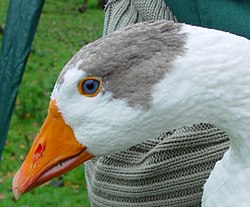
The Twente goose (Dutch : Twentse Landgans) is a rare breed of domestic goose from the Twente region of the Netherlands.

The Twente goose (Dutch : Twentse Landgans) is a rare breed of domestic goose from the Twente region of the Netherlands.

In 1900, Twente geese numbered more than 100,000; [1] in 2011 the population was reported as 110. [2] There are fewer than 20 breeders. [1]
The plumage may be either white or pied grey and white. [3] Twente ganders usually weigh 5–6 kg, and geese 4–5 kg. [1]